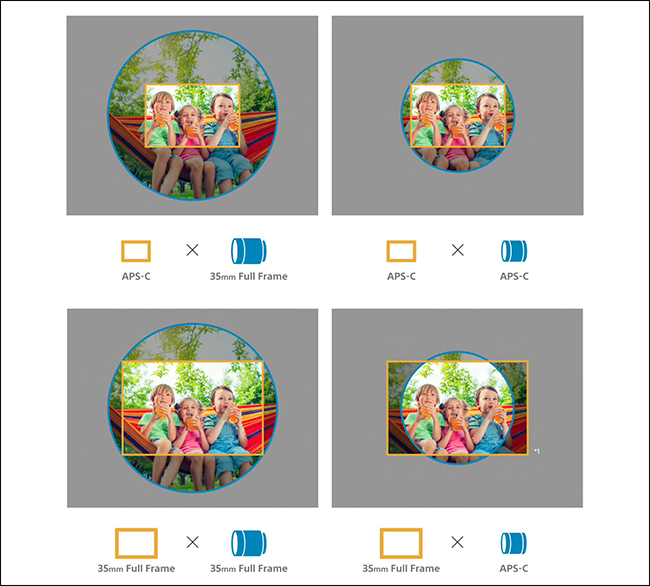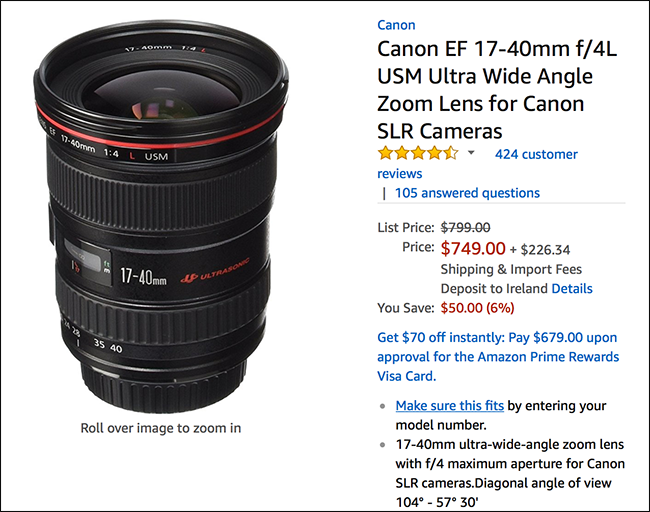Digital cameras have two primary sensor formats: full frame (or 35mm) cameras where the sensor is roughly the same size as a 35mm film frame and crop sensor (or APS-C) cameras where the sensor is just under 2/3 the size. Lenses designed for full frame cameras work on crop sensor cameras, but using crop sensor lenses on full frame cameras is either impossible (Canon) or comes with some serious compromises (Nikon and Sony). If you’ve got a crop sensor camera, it can be tempting just to buy crop lenses, but it’s not always the best idea.
Canon, Nikon, and Sony all make crop sensor and full frame lenses.
- On Canon, EF lenses are designed for full frame cameras; EF-S lenses are only compatible with crop sensor cameras.
- On Nikon, FX lenses are designed for full frame cameras; DX lenses are designed for crop sensor cameras, although kind of work on full frame cameras.
- On Sony, FE lenses are designed for full frame cameras; E lenses are designed for crop sensor cameras, although kind of work on full frame cameras.
Lenses and Sensor Size
Lenses project the “image circle” on to the sensor in your camera. To adequately cover the sensor, lenses designed for crop sensor cameras have to project a smaller image circle than ones designed for full frame cameras. In the image below courtesy of Sony, you can see how the different combinations work.
Since a full frame lens projects an image larger than a full frame sensor, the two work perfectly together. The same is true when you use an APS-C camera and a full frame lens; the sensor is just sampling from a smaller portion of the image circle.
A crop sensor lens on a crop sensor camera works as well. The image circle, although smaller than a full frame lens, is still larger than a crop sensor. It’s only when you have a full frame camera and a crop sensor lens that you have issues: the sensor is larger than the image circle.
Different brands handle this differently. Canon EF-S lenses are incompatible with EF cameras. The lens won’t even mount.
Nikon DX lenses and Sony E lenses will work with FX and FE mounts respectively, however, you have two options:
- The camera can sample only from the area of the sensor that’s inside the image circle. This gives you a decent image but at a lower resolution than your sensor. For example, if you have a 20MP sensor, you’ll have a roughly 12MP image.
- The camera can save the full image. You get a full resolution image but it will likely be heavy vignetted, blurry, or black towards the edge of the frame. You’ll need to make your own crop in post to have a usable image.
So, in short, even if your full frame camera can use crop sensor lenses, it’s not a great idea and you probably won’t get very good photos.
Should You Buy Crop Sensor Lenses?
Crop sensor cameras are significantly cheaper than full frame cameras. Canon, Nikon, and Sony’s entry and mid-level models all have crop sensors; only their high end and professional bodies have full frame sensors. The same is generally true of lenses as well. Lenses designed for crop sensor cameras are a bit cheaper than equivalent lenses designed for full frame cameras.
For example, Canon’s cheapest wide-angle zoom for crop sensor cameras is the Canon EF-S 10-18mm f/4.5-5.6 at $279. The cheapest equivalent full frame lens— regarding the field of view—is the EF 17-40mm f/4L at $749. Sure, there are plenty of other differences like build quality, weather sealing, and the larger zoom range that justify the increased cost, but if you want a wide angle zoom for a crop sensor camera you can have one for less than half the price of one for a full frame camera.
Lenses, even “cheap” ones, are expensive products, so it makes sense that price is a significant factor in a lot of people’s decision-making process. And this is fine as long as you stick with a crop sensor camera, which most people do. However, it’s the people who are most likely to buy more lenses that are also most likely to want to upgrade to a full frame camera in the future, which is the rub.
If you’re in that group and have any plans to upgrade to a full frame camera, you don’t save any money by buying crop sensor lenses even while you still just use a crop sensor camera. At some point in the future, you’ll have to replace those lenses with their equivalents for your full frame kit. You’ll be able to make some money back by selling your lenses, but in reality, you’ll spend more money in total.
Buying full frame lenses—which remember, work on crop sensor cameras as well—also gets you higher optical and build quality. You’re not using the full image circle of the lens, but you’re still getting many other advantages like sharper images, faster autofocus, and the like. Lens quality is more of a factor in how your images look than your camera.
On the other hand, if the price is much more of a factor than image quality and you really don’t see yourself every spending $2000 on a full frame camera, then stick with crop sensor lenses. You’ll get more flexibility with the kind of things you can shoot for a lot less cash.
To put it simply, whether or not crop sensor lenses are right for you depends on what your longterm photography goals are. If you’re going to be sticking with a crop sensor camera for the foreseeable future, then buy away. Otherwise, if you want better quality lenses or the option to go full frame, try and buy full frame compatible lenses.



